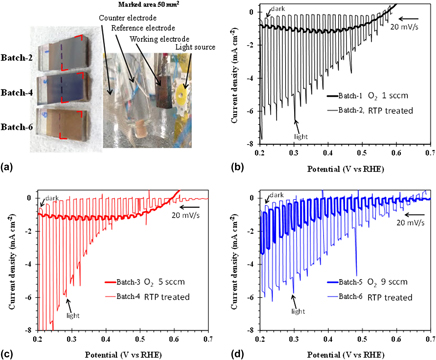Crossref Citations
This article has been cited by the following publications. This list is generated based on data provided by
Crossref.
Kim, Hong-Sik
Yadav, Pankaj
Patel, Malkeshkumar
Kim, Joondong
Pandey, Kavita
Lim, Donggun
and
Jeong, Chaehwan
2017.
Transparent Cu4O3/ZnO heterojunction photoelectric devices.
Superlattices and Microstructures,
Vol. 112,
Issue. ,
p.
262.
Khojasteh, Malak
Haghighat, Shima
Dawlaty, Jahan M
and
Kresin, Vitaly V
2018.
Controlled deposition of size-selected MnO nanoparticle thin films for water splitting applications: reduction of onset potential with particle size.
Nanotechnology,
Vol. 29,
Issue. 21,
p.
215603.
Patel, Malkeshkumar
Kumar, Mohit
Kim, Hong-Sik
Park, Wang-Hee
Choi, Eun Ha
and
Kim, Joondong
2018.
Reactive sputtering growth of Co3O4 thin films for all metal oxide device: a semitransparent and self-powered ultraviolet photodetector.
Materials Science in Semiconductor Processing,
Vol. 74,
Issue. ,
p.
74.
Patel, Malkeshkumar
and
Kim, Joondong
2018.
Optical and electrical features of semitransparent CuO photoelectrochemical cell.
Data in Brief,
Vol. 17,
Issue. ,
p.
681.
Zhao, Xueping
Zhang, Ming
Bai, Pucun
Hou, Xiaohu
Liu, Fei
and
Yan, Hui
2019.
Optical, electrical, and structural properties of Fe-doped CuAlO2 thin films.
Functional Materials Letters,
Vol. 12,
Issue. 01,
p.
1850106.
Wu, Shide
Liu, Jiameng
Cui, Bingbing
Li, Yanling
Liu, Yongkang
Hu, Bin
He, Linghao
Wang, Minghua
Zhang, Zhihong
Tian, Kuan
and
Song, Yingpan
2019.
Fluorine-doped nickel cobalt oxide spinel as efficiently bifunctional catalyst for overall water splitting.
Electrochimica Acta,
Vol. 299,
Issue. ,
p.
231.
Liu, Jian
Xia, Ming
Chen, Rong
Zhu, Xun
Liao, Qiang
Ye, Dingding
Zhang, Biao
Zhang, Wei
and
Yu, Youxu
2019.
A membrane-less visible-light responsive micro photocatalytic fuel cell with the laterally-arranged CdS/ZnS-TiO2 photoanode and air-breathing CuO photocathode for simultaneous wastewater treatment and electricity generation.
Separation and Purification Technology,
Vol. 229,
Issue. ,
p.
115821.
Wang, Zhiliang
Zhang, Lei
Schülli, Tobias U.
Bai, Yang
Monny, Sabiha Akter
Du, Aiju
and
Wang, Lianzhou
2019.
Identifying Copper Vacancies and Their Role in the CuO Based Photocathode for Water Splitting.
Angewandte Chemie International Edition,
Vol. 58,
Issue. 49,
p.
17604.
Wang, Zhiliang
Zhang, Lei
Schülli, Tobias U.
Bai, Yang
Monny, Sabiha Akter
Du, Aiju
and
Wang, Lianzhou
2019.
Identifying Copper Vacancies and Their Role in the CuO Based Photocathode for Water Splitting.
Angewandte Chemie,
Vol. 131,
Issue. 49,
p.
17768.
Hubička, Zdenek
Zlámal, Martin
Olejníček, Jiri
Tvarog, Drahoslav
Čada, Martin
and
Krýsa, Josef
2020.
Semiconducting p-Type Copper Iron Oxide Thin Films Deposited by Hybrid Reactive-HiPIMS + ECWR and Reactive-HiPIMS Magnetron Plasma System.
Coatings,
Vol. 10,
Issue. 3,
p.
232.
Kaur, Gurpreet
Divya
Khan, Saif A.
Satsangi, Vibha R.
Dass, Sahab
and
Shrivastav, Rohit
2020.
Expanded light-absorption and efficient charge-separation: bilayered thin film nano-hetero-structures, CuO/Cu–ZnO, make efficient photoanode in photoelectrochemical water splitting.
Journal of Applied Electrochemistry,
Vol. 50,
Issue. 8,
p.
887.
Siavash Moakhar, Roozbeh
Hosseini‐Hosseinabad, Seyed Morteza
Masudy‐Panah, Saeid
Seza, Ashkan
Jalali, Mahsa
Fallah‐Arani, Hesam
Dabir, Fatemeh
Gholipour, Somayeh
Abdi, Yaser
Bagheri‐Hariri, Mohiedin
Riahi‐Noori, Nastaran
Lim, Yee‐Fun
Hagfeldt, Anders
and
Saliba, Michael
2021.
Photoelectrochemical Water‐Splitting Using CuO‐Based Electrodes for Hydrogen Production: A Review.
Advanced Materials,
Vol. 33,
Issue. 33,
Mohd Shah, Rosmahani
Mohamad Yunus, Rozan
Mastar @ Masdar, Mohd Shahbudin
Jeffery Minggu, Lorna
Wong, Wai Yin
and
Salehmin, Mohd Nur Ikhmal
2021.
High photoelectrochemical performance of a p‐type reduced grapheneoxide‐copperoxide/Cu foil (rGO‐CuO/Cu) photoelectrode prepared by a one‐pot hydrothermal method.
International Journal of Energy Research,
Vol. 45,
Issue. 9,
p.
13865.
Yang, Chang Ping
Wu, Qing
Jiang, Zhong Wei
Wang, Xue
Huang, Cheng Zhi
and
Li, Yuan Fang
2021.
Cu vacancies enhanced photoelectrochemical activity of metal-organic gel-derived CuO for the detection of l-cysteine.
Talanta,
Vol. 228,
Issue. ,
p.
122261.
Divyapriya, G.
Singh, Seema
Martínez-Huitle, Carlos A.
Scaria, Jaimy
Karim, Ansaf V.
and
Nidheesh, P.V.
2021.
Treatment of real wastewater by photoelectrochemical methods: An overview.
Chemosphere,
Vol. 276,
Issue. ,
p.
130188.
Hwang, Jun-Dar
and
Liu, Wan-Yu
2022.
Hybrid visible-blind ultraviolet photodetector based on NiO thin-film phototransistor and p-NiO/n-Si heterojunction diode.
Materials Science in Semiconductor Processing,
Vol. 149,
Issue. ,
p.
106858.
Patel, Malkeshkumar
Satale, Vinayak Vitthal
Kim, Sangho
Lee, Kibum
and
Kim, Joondong
2022.
Transparent photovoltaic-based photocathodes for see-through energy systems.
Journal of Power Sources,
Vol. 548,
Issue. ,
p.
232009.
Chatterjee, Piyali
Ambati, Mounika Sai Krishna
Chakraborty, Amit K.
Chakrabortty, Sabyasachi
Biring, Sajal
Ramakrishna, Seeram
Wong, Terence Kin Shun
Kumar, Avishek
Lawaniya, Raghavendra
and
Dalapati, Goutam Kumar
2022.
Photovoltaic/photo-electrocatalysis integration for green hydrogen: A review.
Energy Conversion and Management,
Vol. 261,
Issue. ,
p.
115648.
Zhao, Lele
Zhang, Jiaming
Zhang, Zhiping
Zhu, Yujun
Zong, Yuan
Bai, Chengying
Wei, Tong
Ren, Yueming
and
Ma, Jun
2023.
Electron-transfer pathways insights into contaminants oxidized by Cu-OOSO3- intermediate: Effects of oxidation states of Cu and solution pH values.
Journal of Hazardous Materials,
Vol. 448,
Issue. ,
p.
130881.
Bandaranayake, Savini
Patnaik, Ananya
Hruska, Emily
Zhu, Quansong
Sokolov, Alexander Yu.
and
Baker, L. Robert
2023.
Electronic Structure and Ultrafast Electron Dynamics in CuO Photocatalysts Probed by Surface Sensitive Femtosecond X-ray Absorption Near-Edge Structure Spectroscopy.
The Journal of Physical Chemistry Letters,
Vol. 14,
Issue. 15,
p.
3643.





